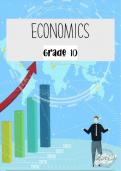Summary
Summary Grade 10_Economics Noteset
- Course
- Institution
Introducing our Grade 10 Economics Workbook - the ultimate study guide for learners pursuing economic studies. This comprehensive guide covers Term 1 to 4 and comes in a colorful format with graphs for easy interpretation. This includes both micro and macroeconomics, as outlined in the ATPS by DBE ...
[Show more]



